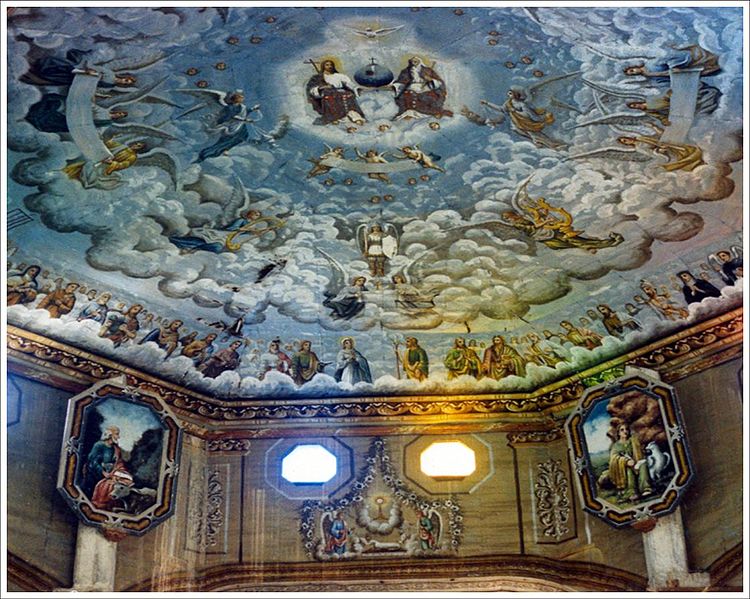|
CALENDAR of the SAINTS
Anno Dómini 11 March 2012

Ceiling Paintings of Balilihan Roman Catholic church
"....and, lo, a great multitude, which no man could number, of all nations, and kindreds, and people, and tongues, stood before the throne, and before the Lamb, clothed with white robes, and palms in their hands; And cried with a loud voice, saying, Salvation to our God which sitteth upon the throne, and unto the Lamb. ~ ~ Apocalypse
Α ☧ Ω
Bishop Saint Aengus the Culdee
Hermit or culdee near the River Nore in Ireland where he was known to commune with angels. Hermit near Maryborough. Monk at Clonenagh in Ireland. His reputation for holiness attracted so many would-be students that he retired to be a lay brother at the monastery of Tallaght near Dublin, Ireland under the abbacy of Saint Maelruan. With Maelruan he wrote the Martyrology of Tallaght in 790. Wrote Felire, a poetic version of the martyrology. These works complete, he resumed life as a hermit and then a bishop.
Α ☧ Ω
Saint Alberta of Agen, Martyr
One of the first martyrs in the persecutions of Diocletian. Martyred A.D. 286 in Agen, France.
Α ☧ Ω
Saint Amunia, Martyr
Married and the mother of Saint Aurea of San Millán. Widow. Hermitess.
Saint Aurea of San Millán
Daughter of Saint Amunia, she grew up a Christian child in a village invaded by Moors. She was devoted to Saint Agatha, Saint Eulalia of Merida, and Saint Cecilia. Benedictine nun and hermit at San Millán de la Cogolla, La Rioja, Spanish Navarre. Received a vision from Agatha, Saint Eulalia of Merida, and Saint Cecilia in which they supported her vocation. Spiritual student of Saint Dominic of Silos. Miracle worker.
Α ☧ Ω
Archbishop Saint Benedict Crispus of Milan
Archbishop of Milan, Italy from A.D. 681 until his death 45 years later. Wrote the epitaph for King Caedwalla of Wessex.
Α ☧ Ω
Saint Candidus the Martyr, Martyr
One of a group of twenty-two martyrs who died together, A.D..257 in North Africa.
Α ☧ Ω
Saint Constantine II, Martyr
Scottish prince, son of King Kenneth II. Murdered A.D.874 in a cave near Crail by Danish invaders. He is onsidered a martyr in Scotland for defending his Catholic land against pagan invaders.
Α ☧ Ω
Saint Constantine of Carthage
Confessor of the faith at Carthage.

Saint Eulogius of Cordoba, Martyr
Son of a senatorial family from Cordoba, Spain. Well educated. Holy Priest. Head of an ecclesiastical school. Worked to comfort and support Christian martyrs and their survivors during muslum persecutions in Moorish occupied Spain. Arrested several times for his faith, he wrote Exhortation to Martyrdom while during one of his imprisonments. Appointed to succeed the Archbishop of Toledo, Spain, but was never consecrated. Imprisoned after he gave shelter to Saint Leocritia of Cordoba, he preached the Gospel in court, then in front of the king‘s counsel. Scourged and beheaded A.D. 11 March 859 at Cordoba, Spain.
Α ☧ Ω
Saint Firmian the Abbot, Martyr
Abbot of San Sabino Piceno near Fermo, Italy.
Α ☧ Ω
Saint Firmus the Martyr, Martyr
Third century martyr.
Α ☧ Ω
Saint Gorgonius the Martyr , Martyr
Third century martyr.
Α ☧ Ω
Saint Heraclius of Carthage, Martyr
Martyred A.D. 263 in Carthage, North Africa, during the persecutions of Valerian and Gallienus.
Blessed John Righi Fabriano
Joined the Franciscan Order A.D. 1484 at Forano, Italy. Lived as a hermit at Cupramontana, Ancona, Italy, preaching and caring for the sick.
Α ☧ Ω
Saint Peter the Spaniard, Martyr
Pilgrim from Spain to Rome. Settled to live as a hermit in Babuco, Italy.
Α ☧ Ω
Saint Piperion the Martyr, Martyr
One of a group of twenty-two martyrs who died together, A.D..257 in North Africa.
Α ☧ Ω
Saint Sophronius
Native of Damascus, Syria. Travelled widely in the East and West. Lived several years at Alexandria, Egypt near Saint John the Almoner. Ecclesiastical writer of distinction. Poet and extensive correspondent; some of his writings have survived. Fought the Monothelitism heresy. Patriach of Jerusalem from A.D. 634 until his death, but was driven from the city by Saracens.
Α ☧ Ω
Saint Thalus the Martyr, Martyr
Crucified A.D. 300 at Laodicea, Syria, during the persecutions of Diocletian.
Saint Thomas Atkinson, Martyr
Studied and was ordained at Rheims, France. Returned to England A.D. 1588 to minister to covert members of the Church of England to Roman Catholicism. He travelled by night, hid by day, and served his flock for decades. Betrayed to the authorities, he was arrested along with the family who was hiding him. Hanged, drawn, and quartered A.D. 11 March 1616 at York, England for the crime of being a Roman Catholic Priest. One of the thousands of Roman Catholic martyrs of England, Scotland and Wales.
Α ☧ Ω
Saint Trophimus, Martyr
Crucified A.D. 300 at Laodicea, Syria, during the persecutions of Diocletian.
Α ☧ Ω
Bishop Saint Vigilius of Auxerre, Martyr
Succeeded Saint Palladius as bishop of Auxerre, France A.D. 661. Murdered by order of Waraton, mayor of the palace.A.D. 685 in a forest near Compiègne, France.
Α ☧ Ω
Saint Vindician of Cambrai
Spiritual student of Saint Eligius. Bishop of Arras-Cambrai, France A.D. 669. Promoted monasticism in his diocese. Protested against the excesses of the Merovingian kings, including Theirry III, and the powerful mayors of the palace. In his later years he retired to the Saint Vaast monastery in Arras, France.
Α ☧ Ω
Saint Zosimus of Carthage, Martyr
Martyred A.D. 263 in Carthage during the persecutions of Valerian and Gallienus.
Α ☧ Ω


|